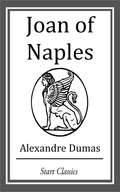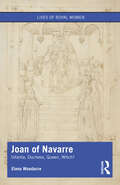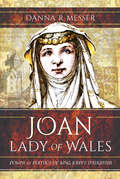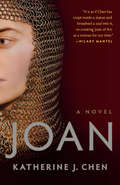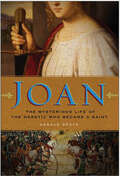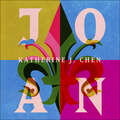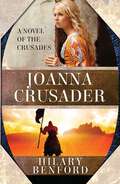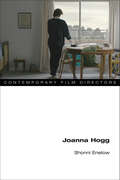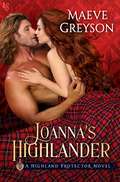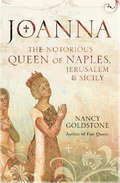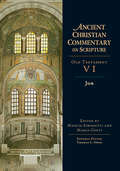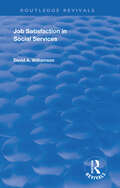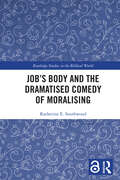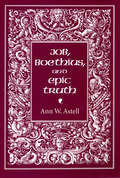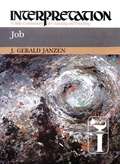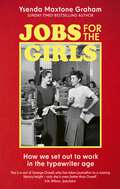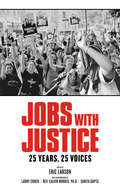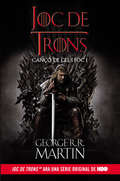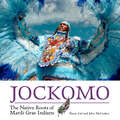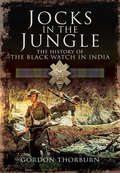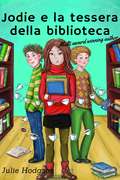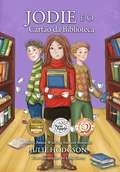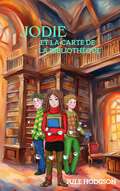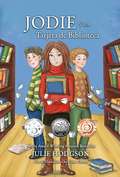- Table View
- List View
Joan of Naples
by Alexandre DumasIt is the story of crimes against the royalty. The vast split between the masses and the elite, the frustration and aggravation in the masses, heedlessness of the authorities and the consequences thereof are depicted. It is a powerful story that highlights the antagonism between the two classes.
Joan of Navarre: Infanta, Duchess, Queen, Witch? (Lives of Royal Women)
by Elena WoodacreThis book is the first full-length biography of Joan of Navarre, a fascinating royal woman who became duchess of Brittany and queen consort of England through her two marriages in 1386 and 1403 respectively. Joan was enmeshed in the turbulent politics of the later Middle Ages as her extensive family and marital connections meant she was related to most of the royal houses of Western Europe—as well as the key protagonists of the Hundred Years War. The large foreign entourage that Joan brought with her to England, and her family ties across the Channel, made her unpopular with her subjects and her loyalties suspect, provoking several purges of her household and culminating in a charge of treason on which she was detained for several years. Yet Joan returned to court in her later years and fought vociferously to the end to retain queenly rights, revenues, and position. Ultimately, this book highlights Joan’s political agency and tenacity, bringing her out of the historical shadows and into the foreground of high politics in fifteenth-century England and Europe. Joan of Navarre is a useful resource for all students and scholars interested in queenship studies, women’s history, and European politics during the later Middle Ages.
Joan, Lady of Wales: Power & Politics of King John's Daughter
by Danna R. MesserThe first account of the life of the illegitimate daughter of King John of England and wife of Llwelyn the Great of Gwynedd.The history of women in medieval Wales before the English conquest of 1282 is one largely shrouded in mystery. For the Age of Princes, an era defined by ever-increased threats of foreign hegemony, internal dynastic strife and constant warfare, the comings and goings of women are little noted in sources. This misfortune touches even the most well-known royal woman of the time, Joan of England (d. 1237), the wife of Llywelyn the Great of Gwynedd, illegitimate daughter of King John and half-sister to Henry III. With evidence of her hand in thwarting a full scale English invasion of Wales to a notorious scandal that ended with the public execution of her supposed lover by her husband and her own imprisonment, Joan’s is a known, but little-told or understood story defined by family turmoil, divided loyalties and political intrigue.From the time her hand was promised in marriage as the result of the first Welsh-English alliance in 1201 to the end of her life, Joan’s place in the political wranglings between England and the Welsh kingdom of Gwynedd was a fundamental one. As the first woman to be designated Lady of Wales, her role as one a political diplomat in early thirteenth-century Anglo-Welsh relations was instrumental. This first-ever account of Siwan, as she was known to the Welsh, interweaves the details of her life and relationships with a gendered re-assessment of Anglo-Welsh politics by highlighting her involvement in affairs, discussing events in which she may well have been involved but have gone unrecorded and her overall deployment of royal female agency.Praise for Joan, Lady of Wales“A seminal, original, and ground-breaking work of simply outstanding scholarship.” —Midwest Book Review
Joan: A Novel of Joan of Arc
by Katherine J. Chen&“This is not your grandmother&’s St. Joan. . . . If every generation gets the Joan it deserves, ours could do worse than an ass-kicking, avenging angel fighting simply for the right to fight.&”—The New York Times Book ReviewWINNER OF THE AMERICAN LIBRARY IN PARIS BOOK AWARD • &“It is as if Chen has crept inside a statue and breathed a soul into it, re-creating Joan of Arc as a woman for our time.&”—Hilary Mantel, #1 New York Times bestselling author of the Booker Prize winner Wolf Hall&“A secular reimagining and feminist celebration of the life of Joan of Arc that transforms the legendary saint into a flawed yet undeniable young woman.&”—USA Today1412. France is mired in a losing war against England. Its people are starving. Its king is in hiding. From this chaos emerges a teenage girl who will turn the tide of battle and lead the French to victory, becoming an unlikely hero whose name will echo across the centuries. In Katherine J. Chen&’s hands, the myth and legend of Joan of Arc is transformed into a flesh-and-blood young woman: reckless, steel-willed, and brilliant. This meticulously researched novel is a sweeping narrative of her life, from a childhood steeped in both joy and violence, to her meteoric rise to fame at the head of the French army, where she navigates the perils of the battlefield and the equally treacherous politics of the royal court. Many are threatened by a woman who leads, and Joan draws wrath and suspicion from all corners, while her first taste of fame and glory leaves her vulnerable to her own powerful ambition. With unforgettably vivid characters, transporting settings, and action-packed storytelling, Joan is a thrilling epic, a triumph of historical fiction, as well as a feminist celebration of one remarkable—and remarkably real—woman who left an indelible mark on history.
Joan: The Mysterious Life of the Heretic Who Became a Saint
by Donald Spoto“A fresh and definitive biography in the context of Joan of Arc’s times.” — International Herald Tribune“Donald Spoto is one of the best biographers in the world today. “ — Acclaimed biographer Mary S. Lovell, author of the national bestselling The Sisters: The Saga of the Mitford Family“A magnificent introduction to one of the most misunderstood and controversial of all the saints.” — James Martin, SJ, editor of America Magazine, author of My Life With the Saints“A worthy contribution to a renewed understanding of a figure who still speaks to today’s realities.” — Library Journal“[An] engaging, and at times gripping, biography.” — Publishers Weekly (starred review)“I have never read a biography that affected me so deeply as a Catholic or as a woman.” — Sr. Joan Chittister, author of Called to Question and columnist for The National Catholic Reporter“Thought provoking and very readable… Joan’s story is significant and should be retold….” — United Press International“…a lively, accessible book …with a cogent discussion of faith, mystery and early church politics.” — Washington Times“[Spoto] approaches his subject with the sophistication of a historian and the admiration of a true believer.” — Washington Post“Spoto is a surprisingly apt biographer for [Joan] ….” — Slate“Spoto’s new biography is like bringing reality TV into a 15th century courtroom . . .a stunning miscarriage of justice.” — Denver Post
Joan: The stunning new feminist reimagining of Joan of Arc for 2022
by Katherine J. ChenA stunning feminist reimagining of the life of Joan of Arc - perfect for fans of Cecily, Ariadne and MatrixGirl. Warrior. Heretic. Saint?France is mired in a losing war against England. Its people are starving. Its king is in hiding. And out of the chaos, an unlikely heroine is emerging.Reckless, steel-willed and brilliant, Joan has survived a childhood steeped in both joy and violence to claim an extraordinary - and fragile - position at the head of the French army. The battlefield and the royal court are full of dangers alike, and Joan finds herself under suspicion from all sides - as well as under threat from her own ambition.With unforgettably vivid characters and propulsive storytelling, Joan is a thrilling epic, a triumph of historical fiction, as well as a feminist celebration of one remarkable - and remarkably real - woman who left an indelible mark on history.PRAISE FOR JOAN'It is as if the author has crept inside a statue and breathed a soul into it, re-creating Joan of Arc as a woman for our time' Hilary Mantel, twice Booker Prize-winning author of The Mirror & the Light'A glorious, sweeping novel . . . Richly imagined, poignant and inspiring' Jennifer Saint, author of Ariadne'Measured, austere, profoundly physical. I loved it' Jo Baker, author of Longbourn'In Katherine J. Chen's capable hands, Joan becomes fully flesh and achingly real' Lisa Wingate, #1 New York Times bestselling author of The Book of Lost Friends 'An epic novel with the mythic power of a fairytale' Christina Baker Kline, #1 New York Times bestselling author of Orphan Train and The Exiles'When you look up the term 'historical fiction' in the dictionary it should say, simply, Read Katherine J. Chen' Steve Berry, New York Times bestselling author of The Kaiser's Web 'A wholly original novel that inspires one's mind and awakens one's soul. With Joan, Katherine J. Chen has created nothing short of a masterpiece' Alyson Richman, USA Today and internationally bestselling author of The Lost Wife 'Beautifully written and confidently told, this is a story of how feminine strength and will can change the world' Megan Chance, bestselling author of A Splendid Ruin'This Joan is of the earth - scrappy and strong, resilient and curious. An ambitious, thrilling novel' Fiona Davis, New York Times bestselling author of The Magnolia Palace 'Katherine J. Chen has stunningly summoned another time and place' M.J. Rose, New York Times bestselling author of The Last Tiara 'Visceral and piercing - I was blown away' Allison Pataki, New York Times bestselling author of The Magnificent Lives of Marjorie Post 'Every era has a need to recast the French maiden warrior in a manner that renews her relevance. In Chen's transporting prose, you will meet a towering new Joan of Arc, one of amazing physical strength, kindness, loyalty, and endurance' Sena Jeter Naslund, author of Ahab's Wife, Four Spirits, and Abundance(P) 2022 Hodder & Stoughton Limited
Joanna Crusader: An epic historical novel of the Crusades
by Hilary BenfordAn epic novel, the sequel to Sister of the Lionheart, revealing the widowed Queen of Sicily&’s role in the Crusades and marriage to the Count of Toulouse. Joanna Plantagenet accompanies her brother Richard the Lionheart on the Third Crusade—the only woman to visit Saracen-held Jerusalem. When she returns to France, Joanna learns that her renowned brother has been captured and held hostage, and with Richard&’s wife Berengaria, she must work for his release. And when Joanna marries for love—a rarity at the time—things go badly wrong when she finds that someone is trying to have her killed . . . This is the conclusion to the grand story of a remarkable heroine from history.
Joanna Hogg (Contemporary Film Directors)
by Shonni EnelowFilms like The Eternal Daughter and the diptych The Souvenir and The Souvenir Part II have cemented Joanna Hogg’s reputation as an original voice in contemporary cinema. Her rigorous and quiet style draws on the histories of film and art to tell stories that weave autobiography with studies in human opacity. Shonni Enelow analyzes Hogg’s six feature films around the concepts of turning away, the reality effect, and the impossible encounter. Throughout, Enelow explores the tension between absorption, in which characters are immersed in a diegetic fiction, and self-reflexivity, as the filmmaker comments on her techniques of representation. An in-depth interview with Hogg delves into the director’s process, approach to creating character, and use of artistic and literary references. Sophisticated and innovative, Joanna Hogg illuminates the work of one of today’s most original filmmakers.
Joanna's Highlander: A Highland Protector Novel (Highland Protectors #2)
by Maeve GreysonPresent-day North Carolina sings with the passions of the Scottish Highlands as a fiery, time-traveling Celtic warrior takes a stubborn tour guide for a wild ride. Haunted by lost love, Grant MacDara still dreams of tenth-century Scotland. Nothing can soothe his aching heart—until a sharp-tongued, redheaded beauty leads a tour of senior citizens through his family’s North Carolina theme park, Highland Life and Legends. Though she’s the polar opposite of the lass he left behind, Joanna Martin is the most irresistible woman Grant has ever met. But when he decides that she’s worth the risk of loving again, he tries so hard to hold her close that she nearly slips through his fingers. Forced out of her job as a pharmaceutical sales rep by a conniving ex, Joanna is trying to make the best of her quiet new life. But one glimpse of Grant—who wields an ancient hammer like it’s just another appendage of his chiseled body—convinces Joanna not to give up on love. The one thing she can’t do is outrun her past as a loser magnet. And although Grant seems to be the last honorable man left on earth, this mouthwatering stud needs a crash course in twenty-first-century women before Joanna can trust him with her heart.
Joanna: The Notorious Queen of Naples, Jerusalem and Sicily
by Nancy GoldstoneThe exceptionally dramatic and previously unchronicled life of the medieval queen Joanna I.On 15 March 1348, Joanna I, Queen of Naples, stood trial for her life before the pope and his court in Avignon. She was 22 years old. Her cousin and husband, Prince Andrew of Hungary, had recently been murdered, and Joanna was the chief suspect. Determined to defend herself, Joanna won her acquittal against enormous odds. Returning to Naples, she ruled over one of Europe's most prestigious and enlightened courts for more than thirty years - until she was herself murdered. As courageous as Eleanor of Aquitaine, as astute and determined as Elizabeth I, Joanna was the only female monarch in her time to rule in her own right. The taint of her husband's death never quite left her, but she was also widely admired. Dedicated to the welfare of her subjects and her realm, she reduced crime, built hospitals and churches, and encouraged the licensing of women physicians. But the turmoil of her times swirled around her: war, plague, intrigue and the treachery that would ultimately bring her down. Nancy Goldstone brings one of history's most remarkable women to life in this impeccably researched and captivating portrait of medieval royalty.
Job (Ancient Christian Commentary on Scripture #6)
by Marco Conti Manlio SimonettiThe book of Job presents its readers with a profound drama concerning innocent suffering. Such honest, forthright wrestling with evil and the silence of God has intrigued a wide range of readers, both religious and nonreligious. Surprisingly, the earliest fathers showed little interest in the book of Job. Not until Origen in the early third century is there much evidence of any systematic treatment of the book, and most of Origen's treatment is known to us only from the catenae. More intense interest came at the end of the fourth century and the beginning of the fifth. The excerpts in this collection focus on systematic treatment. Among Greek texts are those from Origen, Didymus the Blind, Julian the Arian, John Chrysostom, Hesychius of Jerusalem and Olympiodorus. Among Latin sources we find Julian of Eclanum, Philip the Priest and Gregory the Great. Among Syriac sources we find Ephrem the Syrian and Isho'dad of Merv, some of whose work is made available here for the first time in English. In store for readers of this volume is once again a great feast of wisdom from the ancient resources of the church.
Job Satisfaction in Social Services
by David A. WilliamsonFirst published in 1996, this research study explores the job satisfaction in the social and human care workers . Previous job satisfaction research has not been ignored in this area, but that those in the mainstream of job satisfaction research in sociology have been engaged for years in the construction of models of satisfaction built almost entirely on data from business and industry.
Job's Body and the Dramatised Comedy of Moralising: Job’s Body and the Dramatized Comedy of “Advice” (Routledge Studies in the Biblical World)
by Katherine E. SouthwoodThis book focuses on the expressions used to describe Job’s body in pain and on the reactions of his friends to explore the moral and social world reflected in the language and the values that their speeches betray. A key contribution of this monograph is to highlight how the perspective of illness as retribution is powerfully refuted in Job’s speeches and, in particular, to show how this is achieved through comedy. Comedy in Job is a powerful weapon used to expose and ridicule the idea of retribution. Rejecting the approach of retrospective diagnosis, this monograph carefully analyses the expression of pain in Job focusing specifically on somatic language used in the deity attack metaphors, in the deity surveillance metaphors and in the language connected to the body and social status. These metaphors are analysed in a comparative way using research from medical anthropology and sociology which focuses on illness narratives and expressions of pain. Job's Body and the Dramatised Comedy of Moralising will be of interest to anyone working on the Book of Job, as well as those with an interest in suffering and pain in the Hebrew Bible more broadly.
Job, Boethius, and Epic Truth
by Ann W. AstellCalling into question the common assumption that the Middle Ages produced no secondary epics, Ann W. Astell here revises a key chapter in literary history. She examines the connections between the Book of Job and Boethius' s Consolation of Philosophy—texts closely associated with each other in the minds of medieval readers and writers—and demonstrates that these two works served as a conduit for the tradition of heroic poetry from antiquity through the Middle Ages and into the Renaissance. As she traces the complex influences of classical and biblical texts on vernacular literature, Astell offers provocative readings of works by Dante, Chaucer, Spenser, Malory, Milton, and many others.Astell looks at the relationship between the historical reception of the epic and successive imitative forms, showing how Boethius's Consolation and Johan biblical commentaries echo the allegorical treatment of" epic truth" in the poems of Homer and Virgil, and how in turn many works classified as "romance" take Job and Boethius as their models. She considers the influences of Job and Boethius on hagiographic romance, as exemplified by the stories of Eustace, Custance, and Griselda; on the amatory romances of Abelard and Heloise, Dante and Beatrice, and Troilus and Criseyde; and on the chivalric romances of Martin of Tours, Galahad, Lancelot, and Redcrosse. Finally, she explores an encyclopedic array of interpretations of Job and Boethius in Milton's Paradise Lost, Paradise Regained, and Samson Agonistes.
Job: Interpretation (A Bible Commentary for Teaching and Preaching)
by J. Gerald JanzenIn this volume, J. Gerald Janzen examines the text of the book of Job as a literary text within the context of the history of the religion of Israel and within the broader context of the universal human condition. He approaches the basic character of the book from a literary perspective which enables him to identify human existence as exemplified in Job and to expound on the mystery of good and evil, which gives human existence its experiential texture and which together drive humans to ask the same kind of questions asked by Job. This is the first full-length commentary to present Job systematically and literarily.
Jobs and Justice
by Carmela PatriasDespite acute labour shortages during the Second World War, Canadian employers--with the complicity of state officials--discriminated against workers of African, Asian, and Eastern and Southern European origin, excluding them from both white collar and skilled jobs. Jobs and Justice argues that, while the war intensified hostility and suspicion toward minority workers, the urgent need for their contributions and the egalitarian rhetoric used to mobilize the war effort also created an opportunity for minority activists and their English Canadian allies to challenge discrimination.Juxtaposing a discussion of state policy with ideas of race and citizenship in Canadian civil society, Carmela K. Patrias shows how minority activists were able to bring national attention to racist employment discrimination and obtain official condemnation of such discrimination. Extensively researched and engagingly written, Jobs and Justice offers a new perspective on the Second World War, the racist dimensions of state policy, and the origins of human rights campaigns in Canada.
Jobs for the Girls: How We Set Out to Work in the Typewriter Age
by Ysenda Maxtone GrahamA unique take on women's history from the bestselling author of British Summer Time BeginsDrawn from real life, from interviews with women from all sections of society who have ever had a job, this book is a portrait of British women's working lives from 1950, through cardigans and pearls, via mini-skirts and bottom-pinching, to shoulder pads and the ping of the first emails (early 1990s), never forgetting overalls, aprons and uniforms.Graham conveys the full range of experience: to convey the flavour and atmosphere of workplaces in all their character: the jollities as well as the drudgeries, the good men as well as the vile ones, the nasty women as well as the heroines, the office crushes and romances, the daily drudgery, the lunch hours, the parties, the great piles of paper all over the place, the family-feel of workplaces, the daily burden of trying to run a household and family as well: in short, to look at all facets of this rich slice of British life.
Jobs with Justice: 25 Years, 25 Voices
by Larry CohenThrough a series of interviews and essays, this compendium gives voice to the community, labor, immigrant, student, and faith activists that have built Jobs with Justice (JwJ). The book speaks on both the core principles of the organization for workers' rights and the experiences since its founding in 1987. Though the discussion reflects on the last 25 years of the JwJ coalition, it also looks openly and optimistically at the next 25. It includes the perspectives of longtime national leaders, like founder Larry Cohen, newcomers like Ai-Jen Poo of the National Domestic Workers Alliance, and the locally based, working-class men and women who have built JwJ from the ground up.
Joc de Trons (Cançó de gel i foc #Volumen 1)
by George R.R. MartinEl primer llibre de la sèrie «Cançó de gel i foc» inicia l'epopeia més gran de l'edat moderna. Reis i reines, cavallers i renegats, mentiders, senyors i homes honestos. Tots jugaran al Joc de Trons. Els estius s'allarguen durant dècades. L'hivern pot durar tota la vida. I la lluita pel Tron de Ferro ha començat. S'estén des del sud, on la calor engendra conspiracions, luxúria i intrigues, al vast i gèlid nord, on un mur de gel de set-cents peus d'alçada protegeix el regne de les forces de la foscor que es troben més enllà. El Joc de Trons.Guanyaràs o moriràs.
Jockomo: The Native Roots of Mardi Gras Indians
by John McCusker Shane LiefJockomo: The Native Roots of Mardi Gras Indians celebrates the transcendent experience of Mardi Gras, encompassing both ancient and current traditions of New Orleans. The Mardi Gras Indians are a renowned and beloved fixture of New Orleans public culture. Yet very little is known about the indigenous roots of their cultural practices. For the first time, this book explores the Native American ceremonial traditions that influenced the development of the Mardi Gras Indian cultural system. Jockomo reveals the complex story of exchanges that have taken place over the past three centuries, generating new ways of singing and speaking, with many languages mixing as people’s lives overlapped. Contemporary photographs by John McCusker and archival images combine to offer a complementary narrative to the text. From the depictions of eighteenth-century Native American musical processions to the first known photo of Mardi Gras Indians, Jockomo is a visual feast, displaying the evolution of cultural traditions throughout the history of New Orleans. By the beginning of the twentieth century, Mardi Gras Indians had become a recognized local tradition. Over the course of the next one hundred years, their unique practices would move from the periphery to the very center of public consciousness as a quintessentially New Orleanian form of music and performance, even while retaining some of the most ancient features of Native American culture and language. Jockomo offers a new way of seeing and hearing the blended legacies of New Orleans.
Jocks in the Jungle: The History of the Black Watch in India
by Gordon Thorburn"In 1943, there was no thought of good times for two battalions of Scottish soldiers. For them, India meant a new and unimaginably arduous kind of training. Some of the Black Watch boys had seen action in Somaliland, Crete and Tobruk. Some of the Cameronians had fought the Japs in the Burma retreat. Even for these, such training was trial by ordeal. Many more of the Jocks were new, just shipped out from Scotland, but all of them were ordinary men, men from the towns and villages whod taken the Kings shilling in their countrys peril. These were first-class British infantry, but not the super-selected special forces types that we know today. Nevertheless, it was a special-forces job they were supposed to do and that is what they were called, Special Force. The challenge in Madhya Pradesh was to turn themselves into jungle fighters as good as the Japanese. They had a few short months to become Chindits. The two brigades they joined numbered 7,677 officers and men going into the jungle, of whom 531 were killed, captured or missing, and around 1,600 were wounded. By the end, some 3,800 were too sick to fight. Only 1,754 could be classified as 'effective' when they came out and, in truth, half of those were fit for no more than a hospital bed. It was a miracle anybody survived at all. And that was just two of the five brigades that went in. Was this the greatest medical disaster of World War Two? Who caused it? This new book has the answers."
Jodie e la tessera della biblioteca (Le avventure di Jodie Broom #1)
by Julie HodgsonUn’appassionante avventura in giro per il tempo e per la storia. Vincitore del Readers’ Favorite Award. Jodie Broom è una ragazza di 12 anni (quasi 13!). Come la maggior parte delle ragazze della sua età, ama la musica, i suoi amici, ed è sempre pronta per una nuova avventura. Ma ciò che adora più di ogni altra cosa sono i libri. Legge e colleziona qualunque testo possa soddisfare la sua fame di storie, personaggi e informazioni. Purtroppo, Jodie vive nel 2075. Sono passati ormai cinquant’anni da quando i libri sono stati dichiarati illegali, insieme a ogni altro oggetto cartaceo. In questo mondo digitale, le esperienze sono in larga parte simulate, dal cibo sintetico allo zoo che mostra solo filmati di specie estinte. Grazie alla sua tessera della biblioteca, che le permette di viaggiare nel tempo, Jodie scopre di poter assistere a eventi storici memorabili e incontrare personaggi leggendari, riportando di volta in volta a casa libri preziosi da aggiungere alla sua collezione segreta. Ma i viaggi nel tempo hanno anche i loro rischi… Accompagnata dai suoi amici, Jodie si imbarcherà nell’avventura più incredibile della sua vita, fra momenti emozionanti e continui colpi di scena.
Jodie e o cartão da biblioteca
by Julie Hodgson Thamires Silva AraujoJodie Broom, uma garota de 12 anos (quase 13!), é como quase todas as garotas da idade dela. Ela ama seus amigos, música e está sempre pronta para uma boa aventura. O que ela valoriza acima de tudo são os livros e ela só pensa neles, lendo e colecionando tudo o que ela pode para satisfazer sua apetite voraz por histórias, fatos e História. Mas Jodie vive no ano de 2075, e mais de cinquenta anos passaram desde que livros e papel foram proibidos; é uma época em que ninguém pode ter um livro e nem mesmo fotografias impressas. Nesse e-Mundo, as experiências são amplamente simuladas, desde os alimentos reconstituídos até o zoológico que só mostra filmes de todas as espécies extintas. Com seu cartão da biblioteca de estudante, que dá a ela a habilidade de viajar no tempo, Jodie descobre que ela e seus amigos podem presenciar eventos históricos e encontrar personagens legendários. Ela também descobre que pode encontrar e levar para casa seus preciosos livros e mantê-los em segurança em seu esconderijo secreto.
Jodie et la carte de la bibliothèque (Jodie Broom #1)
by Julie HodgsonJodie Broom, une fille de 12 ans (presque 13 ans!), Ressemble à la plupart des filles de son âge. Elle aime ses amis, la musique et est toujours prête pour une bonne aventure. Ce qu’elle aime par-dessus tout, ce sont les livres et elle est consumée par eux, lisant et rassemblant tout ce qu’elle peut pour satisfaire son appétit vorace pour des récits, des faits et l'histoire. Mais Jodie vit en 2075 et plus de cinquante ans se sont écoulés depuis l’interdiction des livres et du papier; c'est un temps où personne ne peut posséder un livre imprimé, ni même imprimer des photographies. Dans ce monde virtuel, les expériences sont largement simulées, de la nourriture reconstituée au zoo qui ne montre que des films de toutes les espèces éteintes. Grâce à sa carte d'étudiant, qui lui permet de voyager dans le temps, Jodie découvre qu'elle et ses amis peuvent vivre des événements historiques et rencontrer des personnages légendaires. Elle peut également retrouver et ramener chez elle ses précieux livres afin de les protéger dans sa cachette secrète.
Jodie y la Tarjeta de Biblioteca
by Betty Serrano Julie HodgsonJodie Broom, una jovencita de 12-años (¡casi 13!), es como la mayoría de las jovencitas de su edad. Ama a sus amigos, su música, y siempre lista para una aventura. Lo que más atesora sobre todas las cosas son sus libros y los necesita, leer y coleccionar todo lo necesario para satisfacer su apetito voraz de leer cuentos, hechos, e historia. Pero Jodie vive en el año 2075, y más de cincuenta años han pasado desde la prohibición de los libros y el papel impreso; es una época donde nadie puede tener un libro impreso, o imprimir fotografías. En este E-mundo, las experiencias son ampliamente simuladas, desde la comida reconstituida hasta el zoológico que solamente muestra filmaciones de las especies de animales en peligro de desaparecer. Con su tarjeta de biblioteca, tiene la habilidad de viajar en el tiempo, y Jodie descubre que ella y sus amigos pueden experimentar eventos en la historia y conocer personajes legendarios, y pueden también encontrar y traer consigo libros valiosos y guardarlos en un lugar secreto y asegurarse de tenerlos a salvo.
